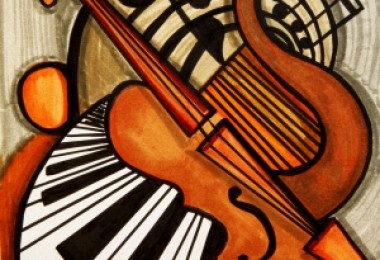Translation Romani has decided to maintain use of the word Romani in all language versions of this website, inclusively and in reference both to the language and people of all the diverse ethnic communities throughout the world, i.e. Roma, Sinti, Manuš, Calé, Romanichal, Kalé, and many others. Please read the important notes from our translators for explanations and other translations currently in use locally, nationally or regionally.
Close this box.
Music is an activity of communication. Ranging from highly organized structures to improvisational frameworks, music unites and arranges diverse components of sound such as melody, harmony, meter, rhythm and lyrics often within a performance context to express sadness, joy, spirituality and many other human emotions. Music is also culturally sensitive and bound to the traditions of song, instrumentation, and musical styles, genres and histories that are part of a community`s heritage. Styles and genres increasingly cross cultural and national boundaries and influence one another, as the growing field of "world music" exemplifies. Concerts and performances are held live locally, but also recorded and uploaded to the Web for the global community as a whole to enjoy. Often, lyrics to songs are informally translated and posted online by fans. In many areas of the world, songs and rhythms have been transmitted through oral tradition from one generation to the next. In other contexts, musical notation is used to compose scores (sheet music) that may be interpreted and performed by others. Some musical traditions and genres rely less on formal composition and more on liberal improvisation. Much of the Romani musical tradition is based on transmitting recurring motifs and techniques (vocal and instrumental) which are then dynamically transformed through individual improvisation. The academic study of music, i.e. musicology, which emerged in late 19th c. Germany during the period of "national consciousness" creation, now embraces many diverse perspectives: cultural theory, sociology, anthropology, ethnology, history, psychology, philosophy, aesthetics, etc. Ethnomusicology studies focus on the social and cultural dimensions of music and dance.
The history of the diffusion of Romani music is a transnational one of complex relationships intertwining multiple musical traditions, beginning with Indian, Middle Eastern, Byzantine and Ottoman Turkish. As in other Romani arts and cultural production, Romani music aesthetics is not confined solely to one nation-state or territory, although some styles and genres are more prevalent in certain areas, and internationally known. For example, in Spain, flamenco guitar, song and dance have been most visibly associated with Romani expression. In Hungary, the "Gypsy Band" (comprised of strings, clarinet, cimbalom) first became well-known through the verbunkos style in the late 18th c. and later as csardas, integrating popular Hungarian folk music within song and dance repertoires. Likewise in the 18th c., Russian Romani choral music built on couplets, romances and a repertory of Russian folk songs. In Bulgaria, Romani musicians gained notoriety and fame at feasts, celebrations, and weddings on a repertoire defined primarily by popular Bulgarian and Turkish songs. The Romani Lăutari in Romania have used the pan flute in addition to strings, and played in tarafs for professional entertainment. In the 20th c., Django Reinhardt (Belgium/France) would introduce "Gypsy Swing" or "Jazz Manouche", a genre that has since been popularized throughout the world. Contemporary Romani music ranges widely from traditional to folk-based, pop, rock, punk, hip hop and rap, and is growing steadily in popularity, with many songs posted on YouTube. Festivals have also increased notably over the past few years, and most, such as Khamoro, have a significant music component. Music traditions travel not only through mass media, but also through migration. For example, some well-known Romani artists in Canada and the United States carry on important Romani violin, accordion, piano, guitar and synthesizer traditions prevalent in their countries of origin. Finally, in addition to the burgeoning performances, films such as Latcho Drom and When the Road Bends: Tales of a Gypsy Caravan have emerged to document, through music, the various musical traditions of Romani peoples all over the globe, including important centers of origin like India and Turkey.
References:
Chinyaeva, Elena. "Hostages of their own music." The Patrin Web Journal (reprinted from Transitions, Vol. 4, No. 4 September 1997).
Georgieva, Nadezhda. "Contestation and negotiation of Romani identity and nationalism through musical standardisation." Romani Studies (16, 1) (Liverpool: Liverpool University Press, June 2006).
Kelly, Eleanor (2012). "Roma Hip-Hop and Rap Emerges Onto World Stage." (Open Society Foundation. 13 September 2012)
Malvinni, David (2004), The Gypsy Caravan. From Real Roma to Imaginary Gypsies in Western Music and Film, New York / London: Routledge.
Randel, Don Michael (ed), The Harvard Dictionary of Music 4th edition (Cambridge: Belknap Press, 2003).
ROMBASE, "Music", University of Graz, Austria. Available online.
Williams, Patrick (1998), Django Reinhardt, Marseille: Éditions Parenthèses.

Mai lashi tiri ryat (Kalderash)
Sov lačho|Lačhi jrat (Gurbeti)
Lashi ratyi, te del o sunto, drago Del! (Lovari)
Lokhi ti rat (Xoraxane)


